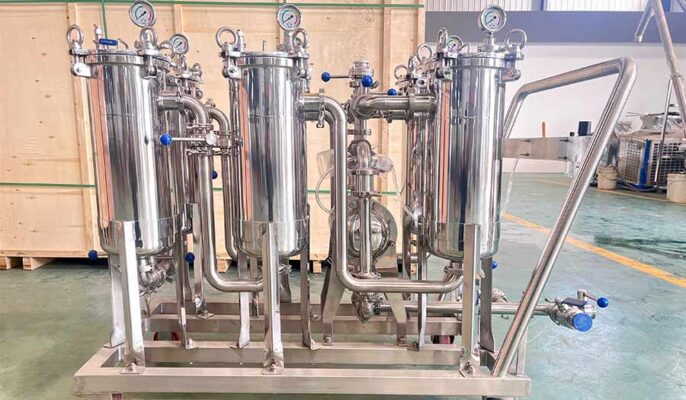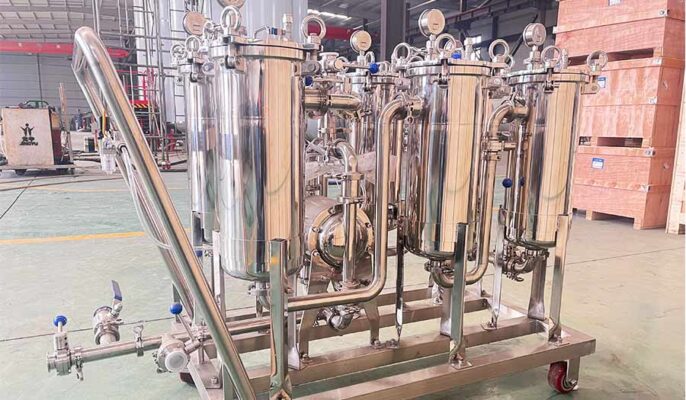ビールの濾過は、ビールの味と品質に影響を与えるだけでなく、最終製品の透明度と安定性にも直接影響する、醸造における最も重要なプロセスの1つです。ビールの濾過は、ビールの透明度を保証するだけでなく、不純物や異臭を除去することによってビールの品質を向上させます。このガイドでは、濾過前の準備、濾過工程の選択、濾過装置の利用など、ビールの濾過工程を詳しく紹介します。
ビールのろ過とは?
ビールはコンディショニング、清澄化、安定化された後、残留酵母、沈殿したタンパク質、ポリフェノールの濁り物質を除去するために濾過される。ビール醸造における濾過の重要な役割は、安定性を与えることである。物理化学的な安定化によって、パッケージング後の濁りや沈殿の発生を防ぎ、微生物学的な安定化によって、ビールの風味を損なう酵母や細菌を除去する。濾過は、飽和レベル以上の二酸化炭素の対圧下、低温(おそらく摂氏-2~-1度、28~30°F)で行われる。濾過は、醸造工程の様々な段階で行うことができ、目的とする結果や製造されるビールの種類によって異なります。
ろ過の対象は、ビール中のさまざまな化合物や粒子である:
- 酵母細胞:酵母は発酵に欠かせないものだが、完成品に残っていると、風味が落ちたり、外観が濁ったりすることがある。
- タンパク質とポリフェノール:これらの化合物は濁りの原因となり、また好ましくない風味や食感につながる可能性がある。
- 微生物:ろ過は、ビールにダメージを与えたり、風味を損なう原因となるバクテリアやその他の微生物を除去するのに役立ちます。
- その他の粒子ろ過は、ホップの破片、穀物の粒子、その他の沈殿物のような大きな粒子も除去する。

ビールのろ過工程
発酵後の準備:ビールを発酵させた後、通常は冷却して放置し、予備処理を行う。この段階の目的は、酵母や穀物の残渣などの固形粒子を液体の底に沈殿させ、その後の濾過をより効果的に行うことである。
- 一次濾過:一次濾過は、ビール醸造工程における最初の濾過工程で、主に物理的な手段によって大きな固体粒子や浮遊物を除去する。
- 二次濾過:二次ろ過は、ビールの透明度と安定性をさらに向上させるためのろ過工程です。この段階では、残留酵母細胞や微細な浮遊物など、より小さな固体粒子や微生物を除去するために、より微細なフィルターや媒体が使用されます。
- 低温ろ過:ペールエールや高度なクラフトビールなど、特別な清澄化が必要なタイプのビールには、低温ろ過を行うことができます。このステップでは、微細な浮遊物質や未溶解固形物をさらに除去し、ビールがより高い透明度と味を実現できるように設計されています。
ビールろ過の種類
ディープ・フィルトレーション
深層濾過とは、ビール中に浮遊する大きな粒子(通常は酵母やタンパク質だが、ポリフェノールやエステルもしばしば含まれる)に結合する媒体をビール中に導入することである。珪藻土とパーライトは、深層濾過に使用される2つの最も一般的なバインダーです。これらの媒体は粉末状であるため、取り扱いには注意が必要である。これらの薬剤を吸い込むと、肺やその他の臓器で粒子と結合する可能性があるため、ワインメーカーはフェイスマスクなどの保護具を着用しなければならない。また、これらの薬剤は高価な傾向にある。
表面ろ過
メッシュ・スクリーンは、目の粗い綿布の現代版で、5ミクロン以上の大型フィルターから0.5ミクロン以下の小型フィルターまで、さまざまなサイズがあります。大きなフィルターは大きな粒子を捕らえますが、ビールに必要な酵母やその他のタンニンを残してしまいます。一方、小さなフィルターは酵母やその他の小さな粒子も捕らえますが、味や香りを取り除いてしまいます。
シングルとダブルフィルターのビール
ビールの透明度を最大にするために、3回ろ過する醸造家もいる。このプロセスでは、深層濾過の後に2種類の表面濾過を行うこともある。大量生産されるビールの多くは、3回濾過を誇っている。
注:ビールを毎回ろ過することのリスクは、風味、アロマ、個性が失われることです。
ろ過システム
ほとんどの表面フィルターはインライン・カートリッジ・フィルターで、スクリーンが詰まったときにカートリッジを取り外し、交換することができる。また、必要に応じてフィルターのサイズを変えることもできます。ほとんどのクラフトビール醸造者は、ビールの本質を取り除かないように、大きめのフィルターから始めることを勧め、孔径が0.5ミクロン以下の最小のフィルターはなるべく使わないようにします。
ビールの濾過にはどんな設備がありますか?
プレート式ビールフィルター
ビールの一次・二次濾過用のシンプルな濾過装置。多孔度の異なるセルロース・プレートが濾材として使用される。ビールは数サイクルで濾過され、最初に粗い孔のプレートを通過し、次に細かい孔のプレートを通過する。このフィルターの欠点は、濾過サイクルのたびに、時間のかかる洗浄と消毒が必要なことである。メリットは、購入価格が安いことだ。プレートフィルターは、小規模なクラフトビール醸造所の立ち上げにおすすめです。
珪藻土ビールフィルター
珪藻土を使ったキャンドルビールフィルターは、ビールの一次濾過から精密濾過まで、最も一般的に使用される機器です。フィルター素材は珪藻土で、太古の藻類の殻を細かく砕いたものです。この珪藻土をステンレス製のキャンドルフィルターに塗布し、フィルターを通過するビールの流れを制御します。珪藻土フィルターの利点は、濾過後の洗浄と消毒が非常に簡単で早いことです。珪藻土層が不純物で目詰まりしても、簡単に素早く洗い流すことができ、すぐに次の濾過サイクルを続けることができる。様々な空隙率を持つ珪藻土は、粗目、中目、細目のビール濾過に使用できます。
ビール精密ろ過ステーション
精密濾過ステーションは、瓶、樽、ビール缶、缶に充填する前のビールの超微細濾過に使用されます。ビールは、交換可能なステンレス製燭台に設置された非常に微細な膜を通してろ過されます。精密ろ過エレメントを適切に選択し組み合わせることで、ビールの微生物学的およびコロイド学的安定化を完全に達成し、小売ネットワーク(特に瓶や缶)にビールを販売するために必要な、非常に長い飲用期間を実現することができます。ビールの精密ろ過は低温殺菌に完全に取って代わるが、飲料を不必要に加熱することはない。そのため、低温殺菌ビールよりも味やその他の官能特性が優れています。
メンブレンフィルター
メンブレンフィルターは、微多孔膜を濾材として濾過する新しいタイプのビール濾過装置である。濾過精度が高く、濾過速度が速いという利点があるが、設備コストが高く、濾過膜を定期的に洗浄・交換する必要がある。

自家醸造のためのろ過プロセス
基本的なろ過オプション
これから始める人たちへ 自家醸 予算が限られている場合は、費用対効果が高く、使いやすいビールろ過オプションがあります。
- ファインメッシュフィルター付き漏斗:ビールをろ過する最も簡単で経済的な方法のひとつです。ファインメッシュフィルターを漏斗の上に置くことで、ホップの残滓や酵母細胞などの大きな粒子が効果的に取り除かれ、よりクリアなビールが出来上がります。
- フィルターバッグ通常ナイロン製かポリエステル製のフィルターバッグは、移し替えの際にビールをろ過するのに使えます。この方法は簡単で、ビールから大きな粒子を取り除くのに役立ちます。
- プレート・フィルター・システム:このシステムは、2枚のプレートの間に設置されたフィルタープレートを利用してビールをろ過します。先に述べたオプションよりも若干投資が必要ですが、プレート濾過システムは濾過効率が高く、小規模な自家醸造に適しています。
高度なろ過オプション
より経験豊富な自家醸造家や、完成品の透明度をより高めたい人は、より高度な濾過方法を選ぶかもしれない。
- カートリッジフィルター:様々な醸造ニーズに対応するため、様々な孔径のフィルターがあり、基本的なフィルターよりも高い濾過効率を提供します。カートリッジフィルターは通常、フィルターハウジングに取り付けられ、より効率的なろ過のためにポンプと一緒に使用することができます。このセットアップにより、流量と圧力をより適切にコントロールし、最適な結果を得ることができます。
- 小型の業務用ろ過システム自家醸造家の中には、出来上がった製品をプロ級の透明度にするために、クロスフローフィルターやデプスフィルターのような小型の業務用濾過システムに投資することを選択する人もいるだろう。これらのシステムは高価で初期投資も大きくなりますが、優れたろ過性能を発揮します。
ろ過アクセサリー
主要な濾過方法に加えて、自家醸造家には濾過プロセスを強化するための様々なアクセサリーを購入する選択肢がある。
- インラインフィルター:このフィルターを樽詰めの際の移送ラインに追加することで、残留粒子を捕捉し、完成ビールの透明度をさらに高めることができます。
- 酸素供給システム:移し替えの過程で適切な酸素供給を行うことは、酵母の健康にとって重要であり、酸化を防ぐのに役立ちます。ビールを濾過する際に酸素を導入し、酵母が健全な発酵に必要な資源を確保するために、インライン酸素供給システムを使用する自家醸造家もいます。
よくある質問
なぜビールのろ過が重要なのか?
ビールをろ過することで、見た目の美しさ、風味、アロマ、一貫性、保存性が向上し、心地よい味わいの高品質な製品が保証される。
ビールはどのように濾過されるのですか?
発酵と清澄化の後、ビールは、必要とされる透明度の程度、ビールの種類、操業規模などの要因に応じて、1つまたは複数の方法を含む濾過システムを通過する。
すべてのビールにフィルターが必要ですか?
いいえ、すべてのビールにろ過が必要なわけではありません。小麦ビールやベルギービールなど、伝統的に無ろ過のビールもあり、濁って見えることもあります。しかし、ほとんどの市販ビールは、透明度と安定性を向上させるために、ある時点でろ過されます。
醸造所に適したビールろ過装置を選ぶには?
適切なろ過装置の選択は、醸造所の規模、製造するビールの種類、予算など、いくつかの要因によって異なります。その ミセット・グループ は、カートリッジフィルター、メンブレンフィルター、フィルターベッセルなど、幅広いろ過製品を提供しています。当社の専門家チームは、お客様のニーズに合った機器の選定や、最適な性能を確保するためのトレーニングやサポートを提供します。




